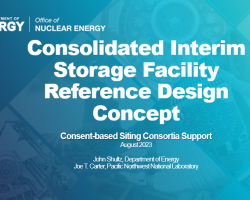Category of Content
Siting Experience Documents Only
Publication Date
Subject Matter
Keywords
Criticality Consequence Analysis Involving Intact PWR SNF in a Degraded 21 PWR Assembly Waste Package
Criticality Consequence Analysis Involving Intact PWR SNF in a Degraded 21 PWR Assembly Waste Package
Intact and Degraded Mode Criticality Calculations for the Codisposal of ATR Spent Nuclear Fuel in a Waste Package
Intact and Degraded Mode Criticality Calculations for the Codisposal of ATR Spent Nuclear Fuel in a Waste Package
Application of Sensitivity/Uncertainty Methods to Burnup Credit Criticality Validation
Application of Sensitivity/Uncertainty Methods to Burnup Credit Criticality Validation
OECD/NEA Burnup Credit Criticality Benchmark, Analysis of Phase II-B Results: Conceptual PWR Spent Fuel Transportation Cask
OECD/NEA Burnup Credit Criticality Benchmark, Analysis of Phase II-B Results: Conceptual PWR Spent Fuel Transportation Cask
Research Supporting Implementation of Burnup Credit in the Criticality Safety Assessment of Transport and Storage Casks
Research Supporting Implementation of Burnup Credit in the Criticality Safety Assessment of Transport and Storage Casks
Radiolytic Specie Generation from Internal Waste Package Criticality
Radiolytic Specie Generation from Internal Waste Package Criticality
Intact and Degrade Mode Criticality Calculations for the Codisposal of TMI-2 Spent Nuclear Fuel in a Waste Package
Intact and Degrade Mode Criticality Calculations for the Codisposal of TMI-2 Spent Nuclear Fuel in a Waste Package
SCALE-4 Analysis of Pressurized Water Reactor Critical Configurations: Volume 3-Surry Unit 1 Cycle 2
SCALE-4 Analysis of Pressurized Water Reactor Critical Configurations: Volume 3-Surry Unit 1 Cycle 2
Probabilistic External Criticality Evaluation
Probabilistic External Criticality Evaluation
The Likelihood of Criticality Following Disposal of SF/HLW/HEU/Pu
The Likelihood of Criticality Following Disposal of SF/HLW/HEU/Pu
Supplement to the Disposal Criticality Analysis Methodology
Supplement to the Disposal Criticality Analysis Methodology
Screening Analysis of Criticality Features, Events, and Processes for License Application
Screening Analysis of Criticality Features, Events, and Processes for License Application
Survey of National Programs for Managing High-Level Radioactive Waste and Spent Nuclear Fuel: 2022 Update
Survey of National Programs for Managing High-Level Radioactive Waste and Spent Nuclear Fuel: 2022 Update
In October 2009, the U.S. Nuclear Waste Technical Review Board (Board or NWTRB) published Survey of National Programs for Managing High-Level Radioactive Waste and Spent Nuclear Fuel. For each of the 13 national programs studied, the report catalogued 15 institutional arrangements that had been set in place and 15 technical approaches that had been taken to design repository systems for the long-term management of high-activity radioactive waste.
Consolidated Interim Storage Facility Reference Design Concept
Consolidated Interim Storage Facility Reference Design Concept
Presentation slides on the Consolidated Interim Storage Facility Reference Design Concept, including site plans; handling, inspection and repackaging concepts and facilities; and cost and staffing estimates.
Summary of Consolidated Interim Storage Advantages and Disadvantages from an Integrated Systems Perspective from Prior Reports and Studies
Summary of Consolidated Interim Storage Advantages and Disadvantages from an Integrated Systems Perspective from Prior Reports and Studies
The question of whether centralized storage of civilian spent nuclear fuel (SNF) should be part of the federal waste management system as an intermediate step before permanent disposal has been debated for more than four decades. Centralized storage facilities were included as a potential component of the U.S. spent fuel management system in the Nuclear Waste Policy Act of 1982 (NWPA), but the NWPA did not identify these facilities as being essential.
Disposition of High-Level Waste and Spent Nuclear Fuel: The Continuing Societal and Technical Challenges
Disposition of High-Level Waste and Spent Nuclear Fuel: The Continuing Societal and Technical Challenges
There has been, for decades, a worldwide consensus in the nuclear technical community for disposal through geological isolation of high-level waste (HLW), including spent nuclear fuel (SNF). However, none of the national programs established to implement geological disposal has yet succeeded in establishing a geological repository and emplacing HLW in it. The large and growing HLW inventory from civilian and military reactor use over nearly 60 years remains in surface facilities intended only for interim storage.



